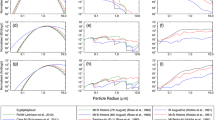Abstract
Volcanic ash cloud has serious impacts on aviation. With volcanic ash dispersion, it also has a profound and long-term impact on climate and the environment. A new volcanic ash cloud detecting method (SWIR-TIR Volcanic Ash method, STVA) is presented that uses satellite images of Medium Resolution Spectral Imager (MERSI) and Visible and Infrared Radiometer (VIRR) on board the second generation Polar-Orbiting meteorological satellite of China (FY-3A). STVA is applied in detecting Iceland’s Eyjafjallajokull volcano eruption. Compared with the traditional Split Window Temperature Difference method (SWTD), the results show that STVA is more sensitive to volcanic ash cloud than SWTD and can fairly extract volcanic ash information from the background of meteorological cloud and the ocean. Ash Radiance Index (ARI) and Absorbing Aerosol Index (AAI) derived from Metop-A satellite images are used to validate the performance of STVA. It is shown that STVA provides similar results with ARI and AAI. FY-3A/MERSI, VIRR and Terra /MODIS data are used to test STVA and SWTD. It is demonstrated that STVA derived from FY-3A satellite data is more effective in complicated meteorological conditions. This study shows great potential of using China’s own new generation satellite data in future global volcanic ash cloud monitoring operation.
Similar content being viewed by others
References
Tupper A, Carn S, Davey J, et al. An evaluation of volcanic cloud detection techniques during recent significant eruptions in the western ‘Ring of Fire’. Remote Sens Environ, 2004, 91: 27–46
Qu C, Shan X, Ma J. Application of satellite thermal infrared remote sensing in detection of volcano activity (in Chinese). Seism Geol, 2006, 28: 99–110
Xu G, Huangfu G. Recent developments in volcanic hazards mitigation. (in Chinese). J Seismol Res, 1998, 21: 397–405
Liu J, Guo Z, Liu Q. Volcanic hazards and monitoring (in Chinese). Quat Sci, 1999, 20: 414–421
Rose W I, Bluth G J S, Ernst G G J. Integrating retrievals of volcanic cloud characteristics from satellite remote sensors: A summary. Phil Trans R Soc Lond A, 2000, 358: 1585–1606
Oppenheimer C. Volcanological applications of meteorological satellites. Int J Remote Sens, 1998, 19: 2829–2864
Krueger A J. Sighting of El Chichón sulfur dioxide clouds with the nimbus 7 total ozone mapping spectrometer. Science, 1983, 220: 1377–1379
Sawada Y. Study on analysis of volcanic eruptions based on eruption cloud image data obtained by the Geostationary Meteorological Satellite (GMS). Technical Report, Meteorological Research Institute, Tsukuba, Japan. 1987
Prata A J. Infrared radiative transfer calculations for volcanic ash clouds. Geophys Res Lett, 1989, 16: 1293–1296
Prata A J. Observations of volcanic ash clouds in the 10–12 μm window using AVHRR/2 data. Int J Remote Sens, 1989, 10: 751–761
Constantine E K, Bluth G J S, Rose W I. TOMS and AVHRR sensors applied to drifting volcanic clouds from the August 1991 eruptions of Cerro Hudson. In: Mouginis-Mark P, Crisp J, Fink J, eds. AGU Monograph 116: Remote Sensing of Active Volcanism. Washington, DC: American Geophysical Union, 2000. 45–64
Krotkov N A, Torres O, Seftor C, et al. Comparison of TOMS and AVHRR volcanic ash retrievals from the August 1992 eruption of Mt. Spurr. Geophys Res Lett, 1999, 26: 455–458
Mccarthy E B, Bluth G J S, Watson I M, et al. Detection and analysis of the volcanic clouds associated with the 18 and 28 August 2000 eruptions of Miyakejima volcano, Japan. Int J Remote Sens, 2008, 29: 6597–6620
Yamanouchi T, Suzuki K, Kawaguchi S. Detection of clouds Antarctica from infrared multispectral data of AVHRR. J Meteorol Soc Jpn, 1987, 65: 949–961
Tupper A C, Davey J P, Potts R J. Monitoring volcanic eruptions in Indonesia and the Southwest Pacific. Occasional Papers Kagoshima Un, 2003, 37: 153–163
Yang J, Dong C, Lu N, et al. FY-3A: The new generation polar-orbiting meteorology satellite of China (in Chinese). Acta Meteorol Sin, 2009, 67: 501–509
Qu W, Bai Y, Huang F, et al. Effect of volcanic activity on the temperature in the tropical upper atmosphere (in Chinese). Chin J Geophys, 2006, 49: 1308–1315
Segelstein D. The complex refractive index of water. M.S. Thesis, University of Missouri—Kansas City, 1981
Gosse S, Labrie D, Chylek P. Refractive index of ice in the 1.4–7.8 μm spectral range. Appl Opt, 1995, 34: 6582–6586
Pollack J B, Toon O B, Khare B N. Optical properties of some terrestrial rocks and glasses. Icarus, 1973, 19: 372–389
Prata F, Bluth G, Rose B, et al. Comments on “Failures in detecting volcanic ash from a satellite-based technique”. Remote Sens Environ, 2001, 78: 341–346
Zhai S, Yao L. Volcanic ash erupted in Philippine (in Chinese). J Chin Electr Microsc Soc, 1993, 2: 183
Author information
Authors and Affiliations
Corresponding author
Rights and permissions
About this article
Cite this article
Zhu, L., Liu, J., Liu, C. et al. Satellite remote sensing of volcanic ash cloud in complicated meteorological conditions. Sci. China Earth Sci. 54, 1789–1795 (2011). https://doi.org/10.1007/s11430-011-4265-3
Received:
Accepted:
Published:
Issue Date:
DOI: https://doi.org/10.1007/s11430-011-4265-3




